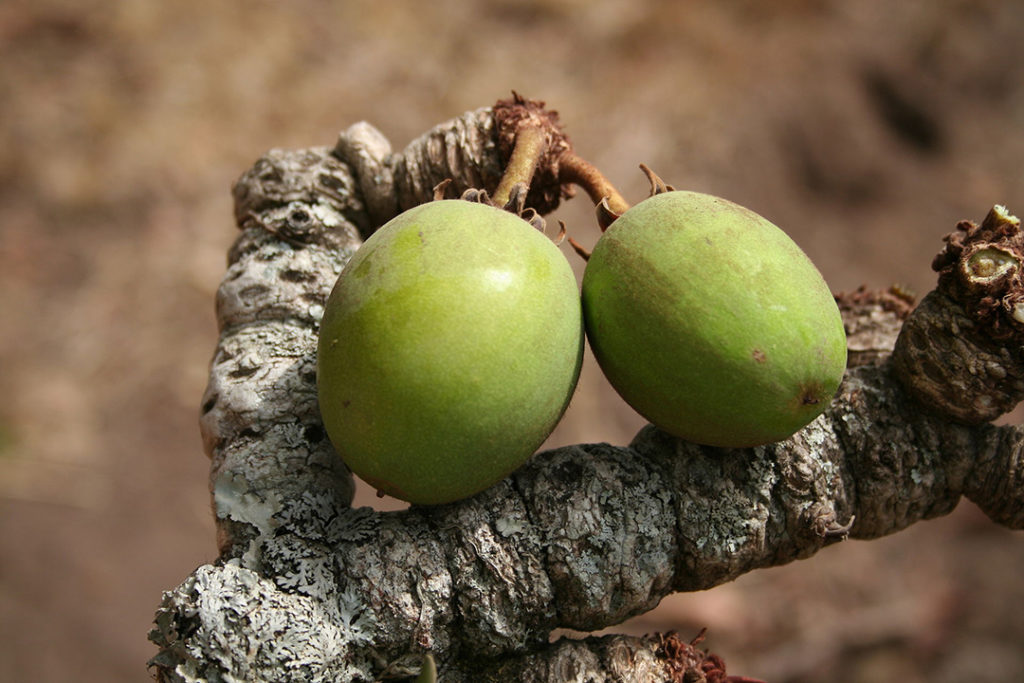
Chad
Karite
Vitellaria Paradoxa (formerly known as Butyrospermum parkii)

General Description / Cultural Significance
The karite tree, Vitellaria paradoxa, grows a nut to make butter, which is invaluable to the people of the country. The tree mostly grows in the south, where it receives the ample water it needs. It is then taken north to be sold in markets. Harvesting karite fruits has traditionally been woman’s work and often they organize themselves into cooperatives and sell shea butter, and in most cases, this supports families. The whole country of Chad knows the karite tree well, as it is used in cuisine, personal care, and cosmetics.
The large oil-rich nut, from which shea butter is made, is extracted from the fruit of the tree. The nutty, earthy smell is part of everyone’s daily lives. It’s a fat that’s used in cooking, or refined and used as a margarine. Because of its emollient properties, it is used to moisturize the skin, particularly the lips and heels, and is also applied to the hair and scalp to promote hair growth. Shea butter is used as a sunblock and lotion, and can also soothe muscle aches. The butter itself is naturally an ivory color, but can vary depending on where it is grown, and is sometimes dyed with borututu root or palm oil.
Climate Change/Conservation Status
In the survey of countries most subject to climate vulnerability, Chad was rated the most in peril due to the combination of high poverty, war, and insurgence, along with an influx of hundreds of thousands of refugees, and the recurrence of droughts and floods.
Lake Chad, the country’s largest body of water, dwindled in size over the past fifty years, and in recent years disappeared entirely. The combination of persistent drought and use of the water to irrigate crops contributed to its demise. With the water went livelihoods of fishing and growing crops. In urban areas, increased suffering has been caused by successive flooding that has overwhelmed insufficient infrastructure, rendering sanitation systems useless, and has left the population vulnerable to an assortment of infectious diseases.
Anthropogenic climate change is having consequences for savanna biomes too, and although more research is required, it is clear that the distribution and genetic pattern of the shea tree is changing. However, the Shea Tree is also described as “self-reliant” and the “ultimate in sustainable agriculture.” It has been able to survive in the sun-seared, drought ridden savanna for centuries, enabled by the tree’s extensive root system. Although it tolerates many harsh conditions and varying soils types, the trees’ yield may be compromised.
Since 1998, the IUCN Red List of Threatened Species has rated the Shea Tree as vulnerable to extinction because it continues to be overexploited for timber, firewood, and charcoal. In addition, its habitat is being eroded by urbanization. The tree is given little protection and with the conditions of the Anthropocene, it can be said the tree is in serious decline.
Alternate Names
Shea tree
Shi tree
Sources
Abdi, A., 2018. Chad is the country most vulnerable to climate change. The Conversation. [website]
Allal, F., et. al., 2011. Past climate changes explain the phylogeography of Vitellaria paradoxa over Africa. Heredity. [website] DOI: 10.1038/hdy.2011.5
Embassy of Chad, Washington, D.C. This statement can be found on the World Sensorium original website.
Makerere University Institute of Environment and Natural Resources, 1998. Vitellaria paradoxa. The IUCN Red List of Threatened Species. [website] DOI: 10.2305/IUCN.UK.1998.RLTS.T37083A10029534.en
National Research Council, 2018. “Chapter 17: Shea”. Lost Crops of Africa: Volume II: Vegetables. The National Academies Press.

